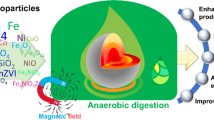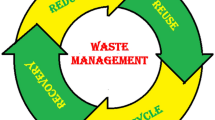Abstract
In this work, the efficiency of extracting lipids from magnetically separated microalgae using ionic liquids (ILs) with subsequent recycling of ILs and magnetic nanoparticles (MNPs) was fully demonstrated for the first time. MNPs were used to separate microalgae from the aqueous phase at a separation efficiency of 99%. The separated microalgae/MNPs slurry was subjected to IL treatment to lyse the microalgae cell wall thereby exposing lipids for efficient solvent extraction using hexane. The lysed cells were mixed with hexane for 2 h to extract the lipids. The extraction efficiency of 99% was achieved when ILs/hexane was used compared to only 5% with hexane only. The extracted lipids were analyzed using gas chromatography-mass spectrometry (GC–MS), Fourier-transform infrared spectroscopy (FT-IR), and nuclear magnetic resonance (1H NMR). These then were transesterified to biodiesel. The MNPs were recovered from cell biomass by sonicating in de-ionized (DI) water and recycled via magnetic separation to harvest more microalgae at a separation efficiency of 96%. Thermogravimetric analysis (TGA) of recycled MNPs confirmed the absence of algal biomass attached to the particles. The ILs were also recycled and analyzed using 1H NMR, mass spectrometry, and FT-IR analysis. All these confirmed the absence of structural alteration in the recycled ILs. Magnetic separation can potentially lower the cost of microalgae harvesting and IL extraction can lower the cost of lipid extraction by 30–50%. A combination of the two processes implies that the extraction of lipids from magnetically separated microalgae could potentially lower the processing cost of biofuels and essential compounds. Recycling MNPs and ILs and extraction of essential compounds alongside microalgae lipids could further lower the processing costs potentially culminating in a lower cost of biofuels compared to petroleum-derived fuels.













Similar content being viewed by others
Abbreviations
- FAME:
-
Fatty acid methyl esters
- HTL:
-
Hydrothermal liquefaction
- ILs:
-
Ionic liquids
- DI:
-
De-ionized water
- MNPs:
-
Magnetic nanoparticles
References
Orr VC, Plechkova NV, Seddon KR, Rehmann L (2015) Disruption and wet extraction of the microalgae Chlorella vulgaris using room-temperature ionic liquids. ACS Sustain Chem Eng 4:591–600
Siddiki SYA, Mofijur M, Kumar PS, Ahmed SF, Inayat A, Kusumo F et al (2022) Microalgae biomass as a sustainable source for biofuel, biochemical and biobased value-added products: an integrated biorefinery concept. Fuel 307:121782
Egesa D, Chuck CJ, Plucinski P (2017) Multifunctional role of magnetic nanoparticles in efficient microalgae separation and catalytic hydrothermal liquefaction. ACS Sustain Chem Eng 6:991–999
Safarik I, Prochazkova G, Pospiskova K, Branyik T (2016) Magnetically modified microalgae and their applications. Crit Rev Biotechnol 36:931–941
Teixeira RE (2012) Energy-efficient extraction of fuel and chemical feedstocks from algae. Green Chem 14:419–427
Singh J, Gu S (2010) Commercialization potential of microalgae for biofuels production. Renew Sustain Energy Rev 14:2596–2610
Boli E, Savvidou M, Logothetis D, Louli V, Pappa G, Voutsas E et al (2021) Magnetic harvesting of marine algae Nannochloropsis oceanica. Sep Sci Technol 56:730–737
Li X, Liu B, Lao Y, Wan P, Mao X, Chen F (2021) Efficient magnetic harvesting of microalgae enabled by surface-initiated formation of iron nanoparticles. Chem Eng J 408:127252
Markeb AA, Llimós-Turet J, Ferrer I, Blánquez P, Alonso A, Sánchez A et al (2019) The use of magnetic iron oxide based nanoparticles to improve microalgae harvesting in real wastewater. Water Res 159:490–500
Almomani F (2020) Algal cells harvesting using cost-effective magnetic nano-particles. Sci Total Environ 720:137621
Bharte S, Desai K (2019) Harvesting Chlorella species using magnetic iron oxide nanoparticles. Phycol Res 67:128–133
Prochazkova G, Podolova N, Safarik I, Zachleder V, Branyik T (2013) Physicochemical approach to freshwater microalgae harvesting with magnetic particles. Colloids Surf, B 112:213–218
Kothari R, Tyagi VV, Pathak VV (2020) Algal biofuel. The Energy and Resources Institute (TERI), Mithapur
Allnutt FT, Kessler BA (2015) Harvesting and downstream processing—and their economics. Biomass and Biofuels from Microalgae. Springer, Berlin, pp 289–310
Prochazkova G, Safarik I, Branyik T (2013) Harvesting microalgae with microwave synthesized magnetic microparticles. Biores Technol 130:472–477
Uduman N, Qi Y, Danquah MK, Forde GM, Hoadley A (2010) Dewatering of microalgal cultures: a major bottleneck to algae-based fuels. J Renew Sustain Energy 2:012701
Halim R, Harun R, Danquah MK, Webley PA (2012) Microalgal cell disruption for biofuel development. Appl Energy 91:116–121
Grøgaard HC (2011) Extraction and analysis of marine lipids with emphasis on phospholipids-evaluation and improvement of methods. Institutt for bioteknologi
Medina AR, Grima EM, Giménez AG, González MI (1998) Downstream processing of algal polyunsaturated fatty acids. Biotechnol Adv 16:517–580
Grima EM, González MJI, Giménez AG (2013) Solvent extraction for microalgae lipids. Algae for biofuels and energy. Springer, Berlin, pp 187–205
Kapoore R, Butler T, Pandhal J, Vaidyanathan S (2018) Microwave-assisted extraction for microalgae: from biofuels to biorefinery. Biology 7:18
Theegala CS (2015) Algal cell disruption and lipid extraction: a review on current technologies and limitations. Algal biorefineries. pp 419–441
Al Hattab M, Ghaly A, Hammouda A (2015) Microalgae harvesting methods for industrial production of biodiesel: critical review and comparative analysis. J Fundam Renew Energy Appl 5:1000154
Pinkert A, Marsh KN, Pang S, Staiger MP (2009) Ionic liquids and their interaction with cellulose. Chem Rev 109:6712–6728
Plechkova NV, Seddon KR (2008) Applications of ionic liquids in the chemical industry. Chem Soc Rev 37:123–150
Tadesse H, Luque R (2011) Advances on biomass pretreatment using ionic liquids: an overview. Energy Environ Sci 4:3913–3929
Earle MJ, Esperança JM, Gilea MA, Lopes JNC, Rebelo LP, Magee JW et al (2006) The distillation and volatility of ionic liquids. Nature 439:831
Wishart JF (2009) Energy applications of ionic liquids. Energy Environ Sci 2:956–961
Tian M, Fang L, Yan X, **ao W, Row KH (2019) Determination of heavy metal ions and organic pollutants in water samples using ionic liquids and ionic liquid-modified sorbents. J Anal Meth Chem 2019:1
Merone GM, Tartaglia A, Rosato E, D’Ovidio C, Kabir A, Ulusoy HI et al (2021) Ionic liquids in analytical chemistry: applications and recent trends. Curr Anal Chem 17:1340–1355
Zavrel M, Bross D, Funke M, Büchs J, Spiess AC (2009) High-throughput screening for ionic liquids dissolving (ligno-) cellulose. Biores Technol 100:2580–2587
Kadokawa R, Endo T, Yasaka Y, Ninomiya K, Takahashi K, Kuroda K (2021) Cellulose preferentially dissolved over xylan in ionic liquids through precise anion interaction regulated by bulky cations. ACS Sustain Chem Eng 9:8686–8691
Mazza M, Catana D-A, Vaca-Garcia C, Cecutti C (2009) Influence of water on the dissolution of cellulose in selected ionic liquids. Cellulose 16:207–215
Egesa D, Mulindwa P, Mubiru E, Kyomuhimbo HD, Aturagaba G (2021) Hydrothermal liquefaction of water hyacinth: effect of process conditions and magnetite nanoparticles on biocrude yield and composition. J Sustain Bioenergy Syst 11:157–186
Egesa D, Chuck CJ, Plucinski P (2018) Multifunctional role of magnetic nanoparticles in efficient microalgae separation and catalytic hydrothermal liquefaction. ACS Sustain Chem Eng 6:991–999
Shankar M, Chhotaray PK, Agrawal A, Gardas RL, Tamilarasan K, Rajesh M (2017) Protic ionic liquid-assisted cell disruption and lipid extraction from fresh water Chlorella and Chlorococcum microalgae. Algal Res 25:228–236
Bligh EG, Dyer WJ (1959) A rapid method of total lipid extraction and purification. Can J Biochem Physiol 37:911–917
Christie WW (1973) Lipid analysis, vol 167. Pergamon press, Oxford
Duvekot C (2019) Determination of total FAME and linoleic acid methyl esters in biodiesel according to EN-14103
Lardon L, Helias A, Sialve B, Steyer J-P, Bernard O (2009) Life-cycle assessment of biodiesel production from microalgae. ACS Publications, Washington DC
Yoo G, Park W-K, Kim CW, Choi Y-E, Yang J-W (2012) Direct lipid extraction from wet Chlamydomonas reinhardtii biomass using osmotic shock. Biores Technol 123:717–722
Olkiewicz M, Caporgno MP, Font J, Legrand J, Lepine O, Plechkova NV et al (2015) A novel recovery process for lipids from microalgæ for biodiesel production using a hydrated phosphonium ionic liquid. Green Chem 17:2813–2824
Fujita K, Kobayashi D, Nakamura N, Ohno H (2013) Direct dissolution of wet and saliferous marine microalgae by polar ionic liquids without heating. Enzyme Microb Technol 52:199–202
Choi S-A, Oh Y-K, Jeong M-J, Kim SW, Lee J-S, Park J-Y (2014) Effects of ionic liquid mixtures on lipid extraction from Chlorella vulgaris. Renew Energy 65:169–174
Young G, Nippgen F, Titterbrandt S, Cooney MJ (2010) Lipid extraction from biomass using co-solvent mixtures of ionic liquids and polar covalent molecules. Sep Purif Technol 72:118–121
Yoo B, **g B, Jones SE, Lamberti GA, Zhu Y, Shah JK et al (2016) Molecular mechanisms of ionic liquid cytotoxicity probed by an integrated experimental and computational approach. Sci Rep 6:19889
Weerachanchai P, Chen Z, Leong SSJ, Chang MW, Lee J-M (2012) Hildebrand solubility parameters of ionic liquids: effects of ionic liquid type, temperature and DMA fraction in ionic liquid. Chem Eng J 213:356–362
Fink JK (2013) Unsaturated polyester resins. Reactive Polymers Fundamentals and Applications. Elsevier, Amsterdam, pp 1–48
Swiderski K, McLean A, Gordon CM, Vaughan DH (2004) Estimates of internal energies of vaporisation of some room temperature ionic liquids. Chem Commun 19:2178–2179
Zhao D, Wu M, Kou Y, Min E (2002) Ionic liquids: applications in catalysis. Catal Today 74:157–189
Remsing RC, Swatloski RP, Rogers RD, Moyna G (2006) “Mechanism of cellulose dissolution in the ionic liquid 1-n-butyl-3-methylimidazolium chloride: a 13 C and 35/37 Cl NMR relaxation study on model systems. Chem Commun 12:1271–1273
Al Hattab M, Ghaly A, Hammoud A (2015) Microalgae harvesting methods for industrial production of biodiesel: critical review and comparative analysis. J Fundam Renew Energy Appl 5:1000154
Ab Rani M, Brant A, Crowhurst L, Dolan A, Lui M, Hassan NH et al (2011) Understanding the polarity of ionic liquids”. Phys Chem Chem Phys 13:16831–16840
Fukaya Y, Hayashi K, Wada M, Ohno H (2008) Cellulose dissolution with polar ionic liquids under mild conditions: required factors for anions. Green Chem 10:44–46
Balasubramanian RK, Doan TTY, Obbard JP (2013) Factors affecting cellular lipid extraction from marine microalgae. Chem Eng J 215:929–936
Kim Y-H, Park S, Kim MH, Choi Y-K, Yang Y-H, Kim HJ et al (2013) Ultrasound-assisted extraction of lipids from Chlorella vulgaris using [Bmim][MeSO4]. Biomass Bioenerg 56:99–103
Halim R, Danquah MK, Webley PA (2012) Extraction of oil from microalgae for biodiesel production: a review. Biotechnol Adv 30:709–732
Sarpal A, Costa I, Teixeira C, Filocomo D, Candido R (2016) Investigation of biodiesel potential of biomasses of microalgaes Chlorella, Spirulina and Tetraselmis by NMR and GC-MS techniques. J Biotechnol Biomater 6:2
Pistorius AM, DeGrip WJ, Egorova-Zachernyuk TA (2009) Monitoring of biomass composition from microbiological sources by means of FT-IR spectroscopy. Biotechnol Bioeng 103:123–129
Acknowledgements
The authors acknowledge funding from the British Government through the Commonwealth Scholarship Commission.
Author information
Authors and Affiliations
Corresponding author
Ethics declarations
Conflict of interest
The authors declare no competing interests.
Additional information
Publisher's note
Springer Nature remains neutral with regard to jurisdictional claims in published maps and institutional affiliations.
Supplementary Information
Below is the link to the electronic supplementary material.
Rights and permissions
About this article
Cite this article
Egesa, D., Plucinski, P. Efficient extraction of lipids from magnetically separated microalgae using ionic liquids and their transesterification to biodiesel. Biomass Conv. Bioref. 14, 419–434 (2024). https://doi.org/10.1007/s13399-022-02377-5
Received:
Revised:
Accepted:
Published:
Issue Date:
DOI: https://doi.org/10.1007/s13399-022-02377-5




